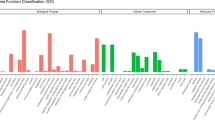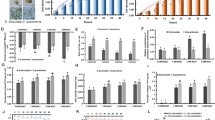Abstract
The past several years witnessed the increasing global interest in the marine green macroalga Ulva prolifera as it is a key causative species of the massive green tides successively occurring in the Yellow Sea. Accurate localization of the ‘seed’ source is one of the principal scientific concerns to be solved before it is possible to manage these algal blooms. It has been suggested that somatic cells of Ulva prolifera which settled in cold benthic sediments might serve as one of the major propagule banks. To identify the molecular mechanisms underlying this hypothesis, PCR-based suppression subtractive hybridization was employed to analyze the differential gene expression of Ulva prolifera under low light and low temperature conditions (matching the cold benthic sediments conditions, 6 °C, 30 μmol photons m−2 s−1). 137 ESTs representing 88 unigenes (80 singletons and 8 contigs) were detected as being over-expressed, whereas 109 unigenes (96 singletons and 13 contigs) in 130 ESTs were found to be down-regulated in this study. BLASTX analysis revealed that 65 % of the over-expressed and 59 % of the down-regulated genes did not belong to any documented functionally annotated or hypothetical proteins in the public database. However, analysis of the functional defined sequences displayed (1) an obvious sign of senescence, (2) enhancements of the photosynthesis system and the pentose phosphate pathway, (3) slow-down of activities in a wide range of processes including the DNA replication, the transcription, the translation, the glycolysis, the citrate cycle and the pyruvate metabolism in Ulva prolifera cells under low light and low temperature conditions. This work disclosed some basic information of the molecular mechanisms of Ulva prolifera cells under low light and low temperature conditions and provides useful clues for future studies on the “seed” source of the massive green tides.



Similar content being viewed by others
References
Altschul SF, Gish W, Miller W, Myers EW, Lipman DJ (1990) Basic local alignment search tool. J Mol Biol 215:403–410
Di Bonaventura MP, DeSalle R, Pop M, Nagarajan N, Figurski DH, Fine DH, Kaplan JB, Planet PJ (2009) Complete genome sequence of Aggregatibacter (Haemophilus) aphrophilus NJ8700. J Bacteriol 191:4693–4694
Diatchenko L, Lau YF, Campbell AP, Chenchik A, Moqadam F, Huang B, Lukyanov S, Lukyanov K, Gurskaya N, Sverdlov ED, Siebert PD (1996) Suppression subtractive hybridization: a method for generating differentially regulated or tissue-specific cDNA probes and libraries. Proc Natl Acad Sci USA 93:6025–6030
Dong M, Zhang X, Zhuang Z, Zou J, Ye N, Xu D, Mou S, Liang C, Wang W (2011) Characterization of the LhcSR gene under light and temperature stress in the green alga Ulva prolifera. Plant Mol Biol Rep. doi:10.1007/s11105-011-0311-8
Estes JE, Higgins PJ (1994) Actin: biophysics, biochemistry, and cell biology. Plenum Press, New York
Fletcher RL (1996) The occurrence of ‘green tides’: a review. In: Schramm W, Nienhuis PH (eds) Marine benthic vegetation: recent changes and the effects of eutrophication. Springer, Berlin, pp 7–43
Hayden HS, Blomster J, Maggs CA, Silva PC, Stanhope MJ, Waaland JR (2003) Linnaeus was right all along: Ulva and Enteromorpha are not genera. Eur J Phycol 38:277–294
Hu C, Li D, Chen C, Ge J, Muller-Karger FE, Liu J, Yu F, He M-X (2010) On the recurrent Ulva prolifera blooms in the Yellow Sea and East China Sea. J Geophys Res 115:C05017. doi:10.1029/2009JC005561
Huang X, Madan A (1999) CAP3: a DNA sequence assembly program. Genome Res 9:868–877
Ji W, Wright M, Cai L, Flament A, Lindpaintner K (2002) Efficacy of SSH PCR in isolating differentially expressed genes. BMC Genomics 3:12
Jiang P, Wang J, Cui Y, Li Y, Lin H, Qin S (2008) Molecular phylogenetic analysis of attached Ulvaceae species and free-floating Enteromorpha from Qingdao coasts in 2007. Chinese J Oceanol Limnol 26:276–279
Koziol AG, Borza T, Ishida K-I, Keeling P, Lee RW, Durnford DG (2007) Tracing the evolution of the light-harvesting antennae in chlorophyll a/b-containing organisms. Plant Physiol 143:1802–1816
Lai CH, Chou CY, Ch’ang LY, Liu CS, Lin W (2000) Identification of novel human genes evolutionarily conserved in Caenorhabditis elegans by comparative proteomics. Genome Res 10:703–713
Largo DB, Sembrano J, Hiraoka M, Ohno M (2004) Taxonomic and ecological profile of ‘green tide’ species of Ulva (Ulvales, Chlorophyta) in central Philippines. Hydrobiologia 512:247–253
Leliaert F, Zhang X, Ye N, Malta E-j, Engelen AH, Mineur F, Verbruggen H, De Clerck O (2009) Research note: identity of the Qingdao algal bloom. Phycol Res 57:147–151
Lin A, Wang C, Qiao H, Pan G, Wang G, Song L, Wang Z, Sun S, Zhou B (2009) Study on the photosynthetic performances of Enteromorpha prolifera collected from the surface and bottom of the sea of Qingdao sea area. Chinese Sci Bull 54:399–404
Liu D, Keesing JK, Xing Q, Shi P (2009) World’s largest macroalgal bloom caused by expansion of seaweed aquaculture in China. Mar Pollut Bull 58:888–895
Liu D, Keesing JK, Dong Z, Zhen Y, Di B, Shi Y, Fearns P, Shi P (2010) Recurrence of the world’s largest green-tide in 2009 in Yellow Sea, China: Porphyra yezoensis aquaculture rafts confirmed as nursery for macroalgal blooms. Mar Pollut Bull 60:1423–1432
Merchant SS, Prochnik SE, Vallon O, Harris EH, Karpowicz SJ, Witman GB, Terry A, Salamov A, Fritz-Laylin LK, Maréchal-Drouard L, Marshall WF, Qu L-H, Nelson DR, Sanderfoot AA, Spalding MH, Kapitonov VV, Ren Q, Ferris P, Lindquist E, Shapiro H, Lucas SM, Grimwood J, Schmutz J, Cardol P, Cerutti H, Chanfreau G, Chen C-L, Cognat V, Croft MT, Dent R, Dutcher S, Fernández E, Fukuzawa H, González-Ballester D, González-Halphen D, Hallmann A, Hanikenne M, Hippler M, Inwood W, Jabbari K, Kalanon M, Kuras R, Lefebvre PA, Lemaire SD, Lobanov AV, Lohr M, Manuell A, Meier I, Mets L, Mittag M, Mittelmeier T, Moroney JV, Moseley J, Napoli C, Nedelcu AM, Niyogi K, Novoselov SV, Paulsen IT, Pazour G, Purton S, Ral J-P, Riaño-Pachón DM, Riekhof W, Rymarquis L, Schroda M, Stern D, Umen J, Willows R, Wilson N, Zimmer SL, Allmer J, Balk J, Bisova K, Chen C-J, Elias M, Gendler K, Hauser C, Lamb MR, Ledford H, Long JC, Minagawa J, Page MD, Pan J, Pootakham W, Roje S, Rose A, Stahlberg E, Terauchi AM, Yang P, Ball S, Bowler C, Dieckmann CL, Gladyshev VN, Green P, Jorgensen R, Mayfield S, Mueller-Roeber B, Rajamani S, Sayre RT, Brokstein P, Dubchak I, Goodstein D, Hornick L, Huang YW, Jhaveri J, Luo Y, Martínez D, Ngau WCA, Otillar B, Poliakov A, Porter A, Szajkowski L, Werner G, Zhou K, Grigoriev IV, Rokhsar DS, Grossman AR (2007) The Chlamydomonas genome reveals the evolution of key animal and plant functions. Science 318:245–250
Morand P, Merceron M (2004) Coastal eutrophication and excessive growth of macroalgae. In: Pandalai SG (ed) Recent research developments in environmental biology, vol 1. Research Signpost, Trivandrum, pp 395–449
Nelson TA, Haberlin K, Nelson AV, Ribarich H, Hotchkiss R, Alstyne KLV, Buckingham L, Simunds DJ, Fredrickson K (2008) Ecological and physiological controls of species composition in green macroalgal blooms. Ecology 89:1287–1298
Pang S, Liu F, Shan T, Xu N, Zhang Z, Gao S, Chopin T, Sun S (2010) Tracking the algal origin of the Ulva bloom in the Yellow Sea by a combination of molecular, morphological and physiological analyses. Mar Environ Res 69:207–215
Pariasca JAT, Sunaga A, Miyazaki T, Hisaka H, Sonoda M, Nakagawa H, Sato T (2001) Cloning of cDNAs encoding senescence-associated genes, ACC synthase and ACC oxidase from stored snow pea pods (Pisum sativum L. var. saccharatum) and their expression during pod storage. Postharvest Biol Technol 22:239–247
Prochnik SE, Umen J, Nedelcu AM, Hallmann A, Miller SM, Nishii I, Ferris P, Kuo A, Mitros T, Fritz-Laylin LK, Hellsten U, Chapman J, Simakov O, Rensing SA, Terry A, Pangilinan J, Kapitonov V, Jurka J, Salamov A, Shapiro H, Schmutz J, Grimwood J, Lindquist E, Lucas S, Grigoriev IV, Schmitt R, Kirk D, Rokhsar DS (2010) Genomic analysis of organismal complexity in the multicellular green alga Volvox carteri. Science 329:223–226
Raffaelli DG, Raven JA, Poole LJ (1998) Ecological impact of green algal blooms. Oceanogr Mar Biol Annu Rev 36:97–125
Rebrikov DV, Desai SM, Siebert PD, Lukyanov SA (2004) Suppression subtractive hybridization. In: Shimkets RA (ed) Methods in molecular biology, vol 258. Gene expression profilingHumana Press, Totowa, pp 107–134
Reysenbach AL, Hamamura N, Podar M, Griffiths E, Ferreira S, Hochstein R, Heidelberg J, Johnson J, Mead D, Pohorille A, Sarmiento M, Schweighofer K, Seshadri R, Voytek MA (2009) Complete and draft genome sequences of six members of the Aquificales. J Bacteriol 191:1992–1993
Schramm W, Nienhuis PH (1996) Introduction. In: Schramm W, Nienhuis PH (eds) Marine benthic vegetation: recent changes and the effects of eutrophication. Springer, Berlin, pp 1–4
Staiger CJ (2000) Actin: a dynamic framework for multiple plant cell functions. Kluwer Academic Publishers, Dordrecht
Sun S, Wang F, Li C, Qin S, Zhou M, Ding L, Pang S, Duan D, Wang G, Yin B, Yu R, Jiang P, Liu Z, Zhang G, Fei X, Zhou M (2008) Emerging challenges: massive green algae blooms in the Yellow Sea. Available from Nature Precedings. http://hdl.handle.net/10101/npre.2008.2266.1
Tang Q, Zhang X, Ye N, Zhuang Z (2010) Review on the research progress on marine green tide. Bull Natl Nat Sci Found China 24:5–9
Vargas-Vila MA, Hannibal RL, Parchem RJ, Liu PZ, Patel NH (2010) A prominent requirement for single-minded and the ventral midline in patterning the dorsoventral axis of the crustacean Parhyale hawaiensis. Development 137:3469–3476
Wang J, Jiang P, Cui Y, Li N, Wang M, Lin H, He P, Qin S (2010a) Molecular analysis of green-tide-forming macroalgae in the Yellow Sea. Aquat Bot 93:25–31
Wang Y, Huo Y, Cao J, Chen L, He P (2010b) Influence of low temperature and low light intensity on growth of Ulva compressa. J Fish Sci China 17:593–599
Ye N, Zhuang Z, Jin X, Wang Q, Zhang X, Li D, Wang H, Mao Y, Jiang Z, Li B, Xue Z (2008) China is on the track tackling Enteromorpha spp. forming green tide. Available from Nature Precedings. http://hdl.handle.net/10101/npre.2008.2352.1
Zhang X, Mao Y, Zhuang Z, Liu S, Wang Q, Ye N (2008) Morphological characteristics and molecular phylogenetic analysis of green tide Enteromorpha sp. occurred in the Yellow Sea. J Fish Sci China 15:822–829
Zhang X, Wang H, Mao Y, Liang C, Zhuang Z, Wang Q, Ye N (2010) Somatic cells serve as a potential propagule bank of Enteromorpha prolifera; forming a green tide in the Yellow Sea, China. J Appl Phycol 22:173–180
Zhang X, Xu D, Mao Y, Li Y, Xue S, Zou J, Lian W, Liang C, Zhuang Z, Wang Q, Ye N (2011) Settlement of vegetative fragments of Ulva prolifera confirmed as an important seed source for succession of a large-scale green tide bloom. Limnol Oceanogr 56:233–242
Acknowledgments
This work was supported by the National Special Fund for Transgenic Project (2009ZX08009-019B), the Natural Science Foundation of Shandong Province (2009ZRA02075), the Hi-Tech Research and Development Program (863) of China (2009AA10Z106), and the National Natural Science Foundation (40972162).
Author information
Authors and Affiliations
Corresponding author
Additional information
Communicated by S. Hohmann.
Y. Li and X. Zhang contributed equally to this work.
Rights and permissions
About this article
Cite this article
Li, Y., Zhang, X., Xu, D. et al. Differential gene expression in Ulva prolifera under low light and low temperature conditions. Curr Genet 58, 235–244 (2012). https://doi.org/10.1007/s00294-012-0380-8
Received:
Revised:
Accepted:
Published:
Issue Date:
DOI: https://doi.org/10.1007/s00294-012-0380-8




